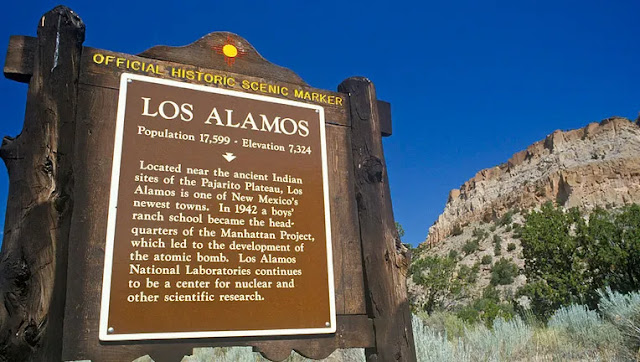Plutonium Pits
New Mexico has more PhDs per capita than any other state in the US, and yet perennially ranks near the bottom for education levels. New Mexico's rural character and high poverty rate contribute to the low quality of education here -- test scores, graduation levels, college participation, achievement measures all rank low even though New Mexico spends exactly the same percentage of its budget on public education as the average in other states.
But we have a lot of highly educated people for such a small population. It's just that they are all concentrated in one isolated area: Los Alamos National Lab. Rocket scientists, physicists, nuclear engineers, chemists. Lots of them.
 |
| It's a thriving, working town and a historical site as well. |
You all know the history of how the Manhattan Project developed an atomic bomb in the remote mountains of New Mexico in the 1940s.
This summer you can watch the story in an epic Christopher Nolan film thriller with Cillian Murphy as Oppenheimer, and Matt Damon with a funny moustache, and a very large cast of big name stars.
 |
| Film coming mid July. |
The town of Los Alamos was built from scratch in an area so remote that its secrecy could be maintained. It's only 33 miles from Santa Fe -- about a 45 minute drive, and many lab workers now live in Santa Fe and commute. But in 1943 it was the middle of absolutely nowhere, accessible by a single dirt road and all uphill.
The hundreds of scientists and their families and other workers arrived by train in Santa Fe and were processed at 109 East Palace Ave., near the plaza, before being driven to "the hill" as townspeople referred to the mysterious site.
 |
| Today 109 E. Palace Ave. in Santa Fe is a storefront. |
For 27 months it was all done in complete secrecy. People arrived, food had to be provided, building materials had to be brought in, and all of this activity went through Santa Fe. And yet Los Alamos and its mission were unknown.
The Lab, or LANL as it's called, is no longer in the middle of nowhere, no longer secret and no longer making nuclear bombs. Well, that's not quite true. In addition to all the research they do on nuclear energy and future materials, the government has tasked them with making pits.
Plutonium pits. Pits are small round nuclear triggers that go on warheads. They are making them now at The Lab, expecting to produce 30 a year over the next few years.
 |
| The Santa Fe New Mexican newspaper got a tour of the pit facility. |
It's controversial. Here's the thing -- the US has committed it will not produce any new nuclear weapons, only maintain the existing arsenal. No new bombs, but we'll keep what we have. It's called stockpile stewardship.
But plutonium decays, and over the years the existing nuclear bombs must have it replaced even just to "keep what we have" in working order. Bombs must work, even if never used. So new plutonium pits must constantly be made and it's not easy.
Safety, transportation, waste and LANL's transparency are all issues northern New Mexicans worry about. Los Alamos is only 33 miles away from Santa Fe. It occupies 36 square miles in the Jemez mountains. Indigenous pueblos are downstream of The Lab's many properties. The Pajarito plateau is on a fault line.
 |
| An aerial view of Los Alamos (from Wikipedia). It looks so remote, but it isn't. |
Material handling procedures and any lapses are constantly being watched and reported. Eighty years of using this mesa top for plutonium tinkering has left lots of things to be examined, some to be fixed, and perhaps some unknowns.
Those are the physical concerns. There are also the intangible issues of having nuclear weapons continue to be made in our general neighborhood, and having our most esteemed neighbors -- scientists and PhDs -- making them.
Comments